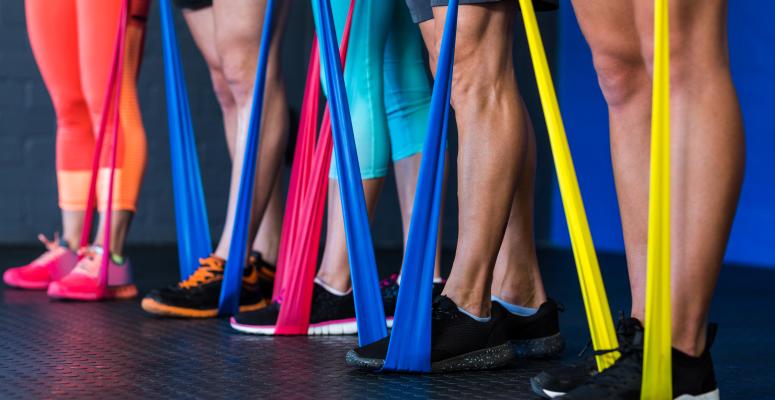
If you’ve started physical therapy and your therapist has recommended that you use exercise bands during treatment, here’s what you need to know. Exercise resistance bands are elastic bands that can be used during workouts to stretch and strengthen the body. They come in a variety of colors and sizes and can be used for many purposes including muscle strengthening, stretching and low-impact exercise. Keep reading to learn about the benefits of exercise bands during physical therapy and what specific types of exercises you can perform using them.
What are the benefits of using exercise bands in physical therapy?
If you’re in physical therapy and your therapist has you using exercise bands during your sessions or has recommended you try them at home, there are a number of reasons why exercise bands could benefit you:
- Useful for rehabilitation — One of the benefits of using exercise bands in physical therapy is that they can be useful for patients who are undergoing rehabilitative treatment. They’re a gentle resistance tool that can be used to stretch and strengthen muscles without placing too much strain or weight on someone recovering from an injury or surgery.
- Great for aerobic exercise — Another benefit of using exercise bands both in and out of physical therapy is that they can be used for aerobic exercise. If you need exercises to improve your cardiovascular health but need to avoid high-impact exercises like running, exercise bands can provide that level of exercise to patients.
- Helpful for building strength — Exercise bands during physical therapy are also helpful for those who aim to build strength. They’re a great alternative to weights and provide resistance training without placing too much strain on the muscles. They can be adjusted to provide low or high resistance and can build increased strength over time.
- Great for stretching exercises — An added benefit of exercise bands is that they can be used to add some diversity to stretching exercises during physical therapy. They’re a tool that you can use to stretch specific parts of your body, which may even prevent injury from occurring in the future. Exercise bands can improve strength, flexibility and range of motion, which can help patients avoid sustaining harmful injuries.
- Convenient home storage — Another benefit of exercise bands is that they’re convenient for keeping at home to use when your physical therapist directs. Most physical therapists will ask their patients to do exercises at home to supplement their in-office sessions. Exercise bands are so versatile that they can be stowed away in even the smallest of spaces. If you’re someone who prefers minimalism when it comes to your home life, exercise bands provide a high level of utility and don’t clutter up your space the way most types of workout equipment do.
What exercises performed during physical therapy can exercise bands be used for?
Now that you know about the general benefits of exercise bands, you may be wondering what specific types of exercises you can use exercise bands for during physical therapy. Here are some common exercises that are used with exercise resistance bands:
- Bent-over row — This exercise is good for improving shoulder and muscle strength. To perform bent-over rows, you’ll need a long exercise band. It should be placed under your feet so that you’re standing on top of the band. Make sure to keep your knees slightly bent. Then, grab each side of the band and hold them at your sides while bending forward at the hips. Make sure the band is taut. Keep your elbows close to your sides and slowly raise your forearms up as you would during a biceps curl. Slowly release your arms back down. Repeat as necessary.
- Banded glute bridge — The banded glute bridge is for strengthening the gluteal muscles and is another exercise that can be performed using an exercise band during physical therapy. To perform the banded glute bridge, you’ll need to lie on your back. Bend your knees with your feet flat on the floor. Your physical therapist will tie an exercise band around your thighs, just above the knees. Lift your hips off the floor slowly until your back is straight and your feet are still flat on the floor. It may help to envision that you’re creating a bridge with your hips. Slowly lower your hips back down, and repeat several times.
- Chest press — The chest press is another exercise that can be done using an exercise band during physical therapy. This exercise is designed to strengthen the muscles in the chest. To perform chest presses, you should lie on your back with your feet on the floor. You’ll need to put the band under your upper back and hold the ends in each hand in the front. Then, while holding the band taut, extend both arms up in front of you with a controlled movement. Lower your arms back down and repeat as necessary.
Alliance PTP can connect you with the physical therapy practice you need to treat your condition with exercise bands
Ready to try in-person physical therapy for your injury or condition? You’ll find plenty of options to choose from among the Alliance Physical Therapy Partners practices nationwide.
Our team can quickly put you in touch with one of our partner clinics near you, and their friendly and knowledgeable local staff can help you find care for your condition and show you how to use exercise bands to supplement your treatment.
Don’t have the time to see a physical therapist in person? Not a problem. Alliance PTP and its partners can also see you virtually in nearly every state.
Still have questions about what we and our partners can do for you? We’re ready to answer them and help you find the physical therapy you need.
Get Help at a Location Near You
